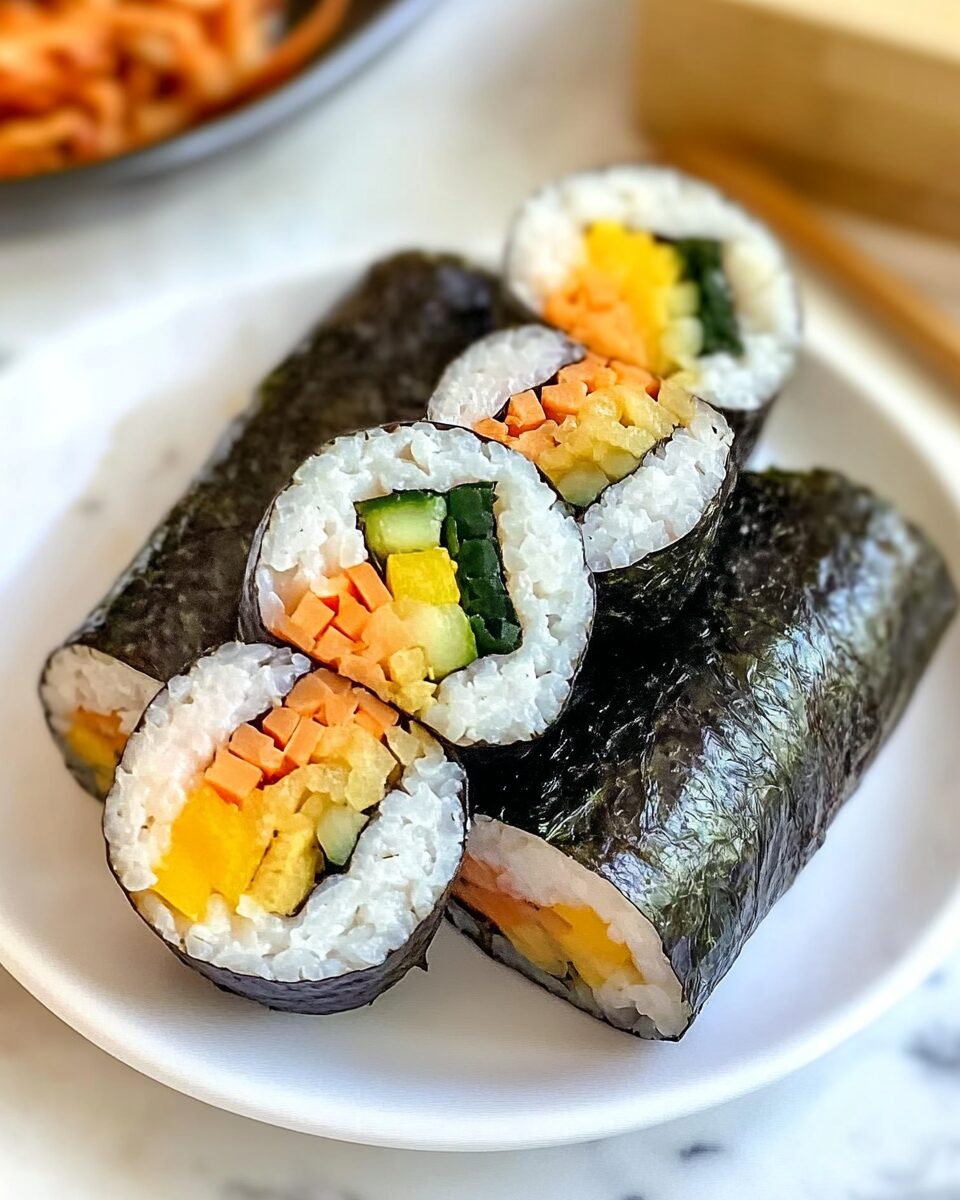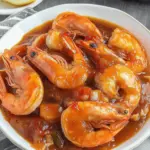The essence of Korean comfort food, these Kimbap rolls are a beloved classic, combining sticky sesame rice, flavorful beef, tender vegetables, and the tangy pop of pickled radish. Wrapped in roasted seaweed, each bite delivers the perfect mix of savory, sweet, and umami in a visually stunning roll.
Whether you’re preparing them for a picnic, road trip, or simply craving a homemade treat, this recipe brings both nostalgia and freshness to the table. It’s a hands-on dish that’s perfect for sharing and a great way to explore Korean flavors without needing dipping sauces or complicated techniques.
Full Recipe:
-
For the Beef:
-
6 oz skirt steak or sirloin, cut into 3 x 1/4-inch strips
-
2 tsp soy sauce
-
1 tsp rice vinegar
-
1 tsp sugar
-
1 clove garlic, grated
-
1 tsp vegetable oil
-
-
For the Rice:
-
4 cups freshly cooked medium-grain white rice
-
2 tsp sesame oil
-
1/2 tsp kosher salt
-
-
For the Spinach:
-
8 oz spinach leaves
-
2 tsp sesame oil
-
1/4 tsp kosher salt
-
-
For the Carrots:
-
1 tsp vegetable oil
-
1 large carrot, peeled and cut into 1/8-inch-wide matchsticks
-
Pinch kosher salt
-
-
For Assembly:
-
6 strips (1/4-inch wide) danmuji (yellow pickled radish)
-
6 sheets gim (roasted seaweed/nori)
-
Sesame oil, for brushing rolls
-
Bamboo or silicone sushi rolling mat
-
Small bowl of water (to dampen fingers and seal rolls)
-
Directions:
-
Marinate the Beef: In a bowl, combine beef with soy sauce, vinegar, sugar, and garlic. Set aside to marinate while prepping other ingredients.
-
Season the Rice: In a large bowl, combine hot rice, sesame oil, and salt. Mix thoroughly and set aside to cool.
-
Cook Spinach: Blanch spinach in boiling water for 15 seconds. Transfer to ice water, drain, and squeeze out excess liquid. Toss with sesame oil and salt.
-
Cook Carrots: In a skillet over medium-high heat, sauté carrot matchsticks in oil for about 1 minute. Add a pinch of salt and remove from heat.
-
Cook the Beef: In the same pan, cook marinated beef for about 4 minutes until done. Set aside with other fillings.
-
Prepare to Assemble: Arrange beef, spinach, carrots, and danmuji on a large plate. Fill a small bowl with water.
-
Roll the Kimbap: Place one sheet of gim (shiny side down) on a bamboo mat. Spread 3/4 cup rice evenly, leaving a 1-inch gap at the top. Layer fillings horizontally in the center.
-
Roll & Seal: Use the mat to roll tightly while tucking fillings inside. Seal edge with damp fingers. Repeat with remaining ingredients.
-
Brush & Slice: Lightly brush finished rolls with sesame oil. Slice each roll into 6–8 pieces using a sharp knife.
-
Serve at room temperature.
Prep Time: 35 minutes | Cooking Time: 20 minutes | Total Time: 55 minutes
Kcal: 285 kcal | Servings: 4 to 6
Introduction to Classic Korean Kimbap
Kimbap (also spelled gimbap) is a vibrant and versatile Korean dish that encapsulates the soul of Korean home cooking. It features rice, vegetables, and proteins tightly rolled in roasted seaweed (gim), then sliced into bite-sized pieces. Though it resembles Japanese sushi at a glance, kimbap is a culinary treasure that stands entirely on its own, both in origin and character.
In Korea, kimbap is far more than just food—it is a symbol of travel, celebration, care, and comfort. Packed in dosirak (Korean lunchboxes), handed out at school picnics, eaten at bus stops, or lovingly made by parents before family road trips, kimbap carries deep emotional resonance. It is the ultimate on-the-go meal, eaten with fingers, no sauces needed, and always full of memories.
The Cultural and Historical Significance of Kimbap
Kimbap’s history is both rich and layered, reflecting Korea’s dynamic past. While its exact origin remains debated, it is generally believed to have developed either as an evolution of traditional Korean food practices (like rolling banchan and rice in gim) or as a Korean interpretation of Japanese norimaki, introduced during Japan’s occupation of Korea in the early 20th century.
Regardless of its historical path, kimbap today is a distinctly Korean creation. The emphasis on sesame-oil-seasoned rice, local vegetables, and uniquely Korean pickled elements like danmuji (yellow pickled radish) sets it apart from any other rolled rice dish globally. It has become a staple in homes, convenience stores, school lunchboxes, and even gourmet Korean restaurants, reflecting its universal appeal across demographics.
What Makes Kimbap Unique
Several distinct features make kimbap a unique culinary experience:
-
Seasoned rice: Unlike sushi rice, which is flavored with rice vinegar and sugar, kimbap rice is gently seasoned with sesame oil and salt, giving it a rich, nutty aroma.
-
No dipping sauces required: Kimbap is a self-contained dish, designed to be eaten without soy sauce, wasabi, or any condiments. Every component is seasoned before assembly, ensuring a perfect bite every time.
-
Customization: There is no fixed filling. From bulgogi (marinated beef) and canned tuna to spam, kimchi, and purely vegetable-based combinations, kimbap adapts to every diet and craving.
-
Visual appeal: Kimbap’s aesthetic is as important as its flavor. Its vibrant, multicolored cross-section—carrot orange, radish yellow, beef brown, spinach green, and rice white—makes it a feast for the eyes and the palate.
Common Variations of Kimbap
Kimbap’s flexibility is one of its greatest strengths. While the classic version includes beef, spinach, carrots, and danmuji, there are numerous variations that showcase different regional and personal styles.
-
Chamchi Kimbap (Tuna Kimbap): Filled with canned tuna mixed with mayonnaise, it’s a popular and easy variation often loved by children.
-
Kimchi Kimbap: A spicier, tangier version featuring sautéed kimchi, often paired with spam or egg for balance.
-
Vegetarian Kimbap: Loaded with assorted vegetables such as cucumber, burdock root, bell pepper, and seasoned tofu, making it a great plant-based option.
-
Cheese Kimbap: Incorporates sliced cheese along with classic fillings, offering a creamy twist.
-
Nude Kimbap: Rolled with the rice on the outside, similar to a California roll, often coated in sesame seeds.
Each version presents a new flavor profile and texture, allowing kimbap to be reinvented in endless ways.
Health Benefits and Nutritional Value
Kimbap isn’t just tasty—it’s also nutritionally balanced. It typically contains:
-
Carbohydrates from rice, providing sustained energy.
-
Proteins from beef, tofu, or tuna, essential for muscle repair and immune function.
-
Vegetables rich in fiber, vitamins, and antioxidants, supporting digestive and cellular health.
-
Healthy fats from sesame oil, which adds both flavor and heart-healthy unsaturated fats.
A single serving of classic beef kimbap contains approximately 285 kcal, 11 grams of fat, 12 grams of protein, and 33 grams of carbohydrates. It’s a well-rounded meal in a compact form, suitable for breakfast, lunch, or snack time.
For those watching their sodium intake or carb consumption, modifications like using brown rice, reducing the pickled radish, or opting for vegetarian fillings can make it even more health-conscious.
Tips for Serving and Eating Kimbap
Kimbap is traditionally eaten at room temperature and is best consumed the same day it’s made. The rice tends to harden in the fridge, which affects the texture significantly. Here are some helpful serving tips:
-
Serve with side dishes: While kimbap doesn’t require sauces, it pairs well with light Korean soups (like miyeok-guk) or a simple miso broth for a fuller meal.
-
Add dipping flair for fusion: For those outside of Korea who enjoy condiments, you can serve kimbap with gochujang-mayo or sweet soy sauce, although this is non-traditional.
-
Make it a picnic star: Because it’s portable, clean to eat, and filling, kimbap is a frequent choice for travel, lunchboxes, and outdoor gatherings.
-
Reheat with creativity: If you have leftovers, dip the sliced rolls in a thin batter and pan-fry for a crispy outer layer—a popular method among Korean families.
Why Kimbap is the Perfect Intro to Korean Cooking
For beginners to Korean cuisine, kimbap is a great gateway recipe. It introduces foundational Korean ingredients like gim, sesame oil, danmuji, and blanched spinach, while also encouraging a hands-on approach to food prep. The rolling technique, while initially challenging, becomes second nature after a few tries and gives a deep sense of accomplishment.
Unlike many other traditional Korean dishes that require fermentation or long simmering times, kimbap can be completed in under an hour. It’s interactive, colorful, customizable, and most importantly, satisfying.
Modern Popularity and Global Reach
With the rise of Korean pop culture globally, especially through K-pop, K-dramas, and Korean YouTube cooking channels, kimbap has seen a surge in international recognition. It is now common to find kimbap in major cities around the world, from food trucks in Los Angeles to Korean groceries in Paris.
Social media platforms like TikTok and Instagram have further propelled kimbap into the spotlight, with influencers showcasing visually perfect rolls, inventive fillings, and mukbang-style eating videos. As interest in global home cooking grows, kimbap continues to gain fans who are eager to try it both as a homemade project and as a grab-and-go meal.
Conclusion
Kimbap is more than just a food—it’s a cultural emblem, a portable celebration, and a delicious memory wrapped in seaweed. It combines balance, flavor, nutrition, and fun, making it one of Korea’s most beloved dishes both domestically and abroad.
Whether you’re packing lunch for your kids, looking for a new dish to try with friends, or exploring international cuisine at home, kimbap is the perfect recipe to start with. Its forgiving nature, endless variations, and deeply satisfying flavors ensure that it can be tailored to any lifestyle or palate.
In a world of fast food and instant meals, kimbap offers a joyful reminder that homemade food—rolled by hand and filled with care—is always worth the effort.






